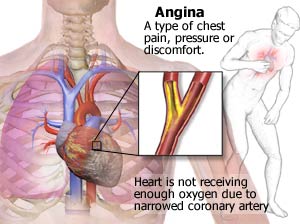Angina is a specific type of chest discomfort caused by inadequate blood flow
through the blood vessels (coronary vessels) of the heart muscle (myocardium).
Angina affects approximately 3% to 5% of the population in the U.S. The most
common cause is coronary artery disease (CAD) In CAD, blockages in the coronary
arteries, called plaques, prevent an adequate amount of blood from reaching the
heart muscle. Situations that require increased blood flow to the heart may cause
angina in people with CAD. These include exercise, heavy meals, and stress.
 There are two types of
angina: stable and unstable. Stable angina is a pain
or discomfort in the chest or adjacent areas caused
by insufficient blood flow to the heart muscle. This
chest pain is relieved by rest or medication within
a short period of time, usually 15 minutes. Chest pain
of a longer duration or pain appearing with a lower
level of effort than before, even at rest, should be
considered unstable angina. Unstable angina describes
a syndrome that is intermediate between stable angina
and myocardial infarction: an accelerating or "crescendo" pattern
of chest pain that lasts longer than stable angina,
occurs with less exertion or at rest, or is less responsive
to medication. There are two types of
angina: stable and unstable. Stable angina is a pain
or discomfort in the chest or adjacent areas caused
by insufficient blood flow to the heart muscle. This
chest pain is relieved by rest or medication within
a short period of time, usually 15 minutes. Chest pain
of a longer duration or pain appearing with a lower
level of effort than before, even at rest, should be
considered unstable angina. Unstable angina describes
a syndrome that is intermediate between stable angina
and myocardial infarction: an accelerating or "crescendo" pattern
of chest pain that lasts longer than stable angina,
occurs with less exertion or at rest, or is less responsive
to medication.
Unstable angina and myocardial
infarction are considered acute coronary syndromes,
while stable angina is a chronic condition. Unstable
angina occurs in approximately 6 out of every 10,000
people. Coronary artery disease due to atherosclerosis
is by far the most common cause of unstable angina.
The risk factors for CAD (which in turn causes angina)
include the following: |
- Male Gender
- Cigarette smoking
- High cholesterol levels (in particular, high LDL
and low HDL cholesterol)
- High blood pressure (hypertension)
- Diabetes
- Family history of coronary heart disease before age
55
- Sedentary lifestyle
- Obesity
Symptoms include feeling of tightness, heavy pressure, or squeezing or
crushing chest pain that:
- is mid-sternal (under the breastbone) or slightly
to the left
- is not clearly localized
- may radiate to shoulder, arm, jaw, neck, back, or
other areas
- may feel similar to gas or indigestion
- is precipitated by activity, stress, or exertion
- lasts 1 to 15 minutes
- is usually relieved by rest and/or nitroglycerin
Your health care provider may note changes in your
blood pressure. A heart murmur or arrhythmias (irregular
heartbeats) may occur. An exercise tolerance test (stress
test or treadmill test) may show ECG changes associated
with the chest pain, which confirm the diagnosis of coronary
artery disease in patients with angina.
A stress echocardiogram may show that the heart's ability
to squeeze (contract) is altered. In some circumstances,
your health care provider may request a heart scan or
a coronary angiography to help assess the condition.
Some patients may need revascularization procedures
to treat the underlying coronary artery disease. Revascularization
procedures include PTCA (balloon angioplasty to a coronary
artery) and surgery such as CABG (coronary artery bypass
grafting). |